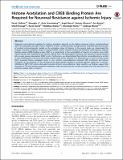| dc.contributor.author | Yildirim, Ferah | |
| dc.contributor.author | Ji, Shengbo | |
| dc.contributor.author | Kronenberg, Golo | |
| dc.contributor.author | Barco, Angel | |
| dc.contributor.author | Olivares, Roman | |
| dc.contributor.author | Benito, Eva | |
| dc.contributor.author | Dirnagl, Ulrich | |
| dc.contributor.author | Gertz, Karen | |
| dc.contributor.author | Endres, Matthias | |
| dc.contributor.author | Harms, Christoph | |
| dc.contributor.author | Meisel, Andreas | |
| dc.date.accessioned | 2014-07-01T18:38:53Z | |
| dc.date.available | 2014-07-01T18:38:53Z | |
| dc.date.issued | 2014-04 | |
| dc.date.submitted | 2013-11 | |
| dc.identifier.issn | 1932-6203 | |
| dc.identifier.uri | http://hdl.handle.net/1721.1/88169 | |
| dc.description.abstract | Epigenetic transcriptional regulation by histone acetylation depends on the balance between histone acetyltransferase (HAT) and deacetylase activities (HDAC). Inhibition of HDAC activity provides neuroprotection, indicating that the outcome of cerebral ischemia depends crucially on the acetylation status of histones. In the present study, we characterized the changes in histone acetylation levels in ischemia models of focal cerebral ischemia and identified cAMP-response element binding protein (CREB)–binding protein (CBP) as a crucial factor in the susceptibility of neurons to ischemic stress. Both neuron-specific RNA interference and neurons derived from CBP heterozygous knockout mice showed increased damage after oxygen-glucose deprivation (OGD) in vitro. Furthermore, we demonstrated that ischemic preconditioning by a short (5 min) subthreshold occlusion of the middle cerebral artery (MCA), followed 24 h afterwards by a 30 min occlusion of the MCA, increased histone acetylation levels in vivo. Ischemic preconditioning enhanced CBP recruitment and histone acetylation at the promoter of the neuroprotective gene gelsolin leading to increased gelsolin expression in neurons. Inhibition of CBP's HAT activity attenuated neuronal ischemic preconditioning. Taken together, our findings suggest that the levels of CBP and histone acetylation determine stroke outcome and are crucially associated with the induction of an ischemia-resistant state in neurons. | en_US |
| dc.description.sponsorship | German Research Foundation (Exc 257) | en_US |
| dc.description.sponsorship | Germany. Federal Ministry of Education and Research (01 EO 08 01) | en_US |
| dc.description.sponsorship | Hermann von Helmholtz-Gemeinschaft Deutscher Forschungszentren (SO-022NG) | en_US |
| dc.description.sponsorship | European Union (7th Framework Programme (FP7/2007–2013) grant agreement no. 201024) | en_US |
| dc.language.iso | en_US | |
| dc.publisher | Public Library of Science | en_US |
| dc.relation.isversionof | http://dx.doi.org/10.1371/journal.pone.0095465 | en_US |
| dc.rights | Creative Commons Attribution | en_US |
| dc.rights.uri | http://creativecommons.org/licenses/by/4.0/ | en_US |
| dc.source | Public Library of Science | en_US |
| dc.title | Histone Acetylation and CREB Binding Protein Are Required for Neuronal Resistance against Ischemic Injury | en_US |
| dc.type | Article | en_US |
| dc.identifier.citation | Yildirim, Ferah, Shengbo Ji, Golo Kronenberg, Angel Barco, Roman Olivares, Eva Benito, Ulrich Dirnagl, et al. “Histone Acetylation and CREB Binding Protein Are Required for Neuronal Resistance Against Ischemic Injury.” Edited by Christoph Kleinschnitz. PLoS ONE 9, no. 4 (April 18, 2014): e95465. | en_US |
| dc.contributor.department | Massachusetts Institute of Technology. Department of Biological Engineering | en_US |
| dc.contributor.mitauthor | Yildirim, Ferah | en_US |
| dc.relation.journal | PLoS ONE | en_US |
| dc.eprint.version | Final published version | en_US |
| dc.type.uri | http://purl.org/eprint/type/JournalArticle | en_US |
| eprint.status | http://purl.org/eprint/status/PeerReviewed | en_US |
| dspace.orderedauthors | Yildirim, Ferah; Ji, Shengbo; Kronenberg, Golo; Barco, Angel; Olivares, Roman; Benito, Eva; Dirnagl, Ulrich; Gertz, Karen; Endres, Matthias; Harms, Christoph; Meisel, Andreas | en_US |
| mit.license | PUBLISHER_CC | en_US |
| mit.metadata.status | Complete | |
